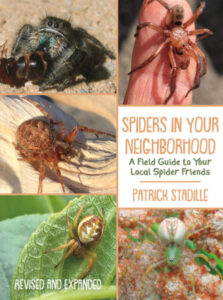When it comes to lists of common phobias, arachnophobia – the fear of spiders – almost always makes the top ten, and more often than not, the top five. Some have even argued that the fear of spiders, like the fear of snakes, is an innate fear – people are simply born with it thanks to it being selected over millennia of human evolution. Those who instinctively avoided such potentially harmful creatures tended to survive and reproduce. Unfortunately, for a large portion of the human population today, the fear of spiders is one that has long outlived its potential benefit.
As for myself, I’ve never been particularly bothered by spiders. Indeed, I can remember as a boy watching with awe the emergence of large numbers of tiny yellow and black orb weaver spiderlings emerging from their nurseries in the spring. I can’t recall ever thinking they were creepy or dangerous; I can only remember wondering where they were all going. When our daughter was very young, knowing that other children and adults would soon be telling her how scary spiders were, I took every opportunity I could to show her (as I would do with many plants and animals over the years) that spiders were part of the natural world, that they all play a role in keeping nature in balance, that they were all beautiful in their own ways, and that they wouldn’t hurt her unless she sought to hurt them. It worked – she, like me – now regards spiders with a welcoming attitude and – also like me – sometimes even greets them as familiar friends upon seeing them.
I like to think that if my daughter and I ever met Patrick Stadille, we’d have a great time talking about spiders. I think this as during my reading of his recently revised and expanded book Spiders in Your Neighborhood: A Field Guide to Your Local Spider Friends, a remarkable amount of agreement was found between how I try to teach people about spiders and how he does – with one important difference; I suspect he is much better at communicating with young people than I am.
In his book, Mr. Stadille guides his young readers – and it is to be hoped their parents as well – through the basics of spider life and behavior. His tone is friendly and enthusiastic, and his choice of words very much vernacular and casual, and many of his explanations include personal experiences, either his own or those of his students (he’s a science teacher – and quite an effective one I’ll wager). Even the style of the printing reflects this open and welcoming tone. The font chosen is a hand printed style that looks like what an enthusiastic young person would use if he or she was creating a book about spiders. It’s very well suited to the purpose; however I will admit that for older eyes it may be a bit challenging in some of the small, off-hand style comments he includes beside some of the pictures.
From here, the book moves on to short, lively chapters that present seventeen different types of spiders. Rather that rigorously drilling down through the taxonomy to individual species, he rather presents his subjects in groups such as funnel web spiders, orb weavers,cobweb weavers, etc. Then in explaining each of these groups, he uses specific examples of spiders that his readers are likely to see – if they pay attention, of course. While that doesn’t make this perhaps a “field guide” as you or I might think of one for ourselves, for a young reader, such presentations are very effective as they lay out the welcome mat and open the door to then be walked through of the reader’s own accord, letting his or her respective level of curiosity and interest do the rest. This grouping presentation also makes the book widely applicable geographically as by not focusing closely on individual species, and by encouraging personal observations of spiders by the readers themselves, anyone anywhere can take what it contains and use it as a foundation to learn more about the spiders in their respective areas.
Finally, Mr. Stadille wraps up with short chapters on how to observe and record information about spiders, what professional arachnologists do, a reminder of why spiders are important to respect and protect, and a list of books that interested readers can turn to next to learn even more about spiders. It is in this that I offer him and this book my particular commendation for one of the most important elements of any didactic presentation is direction in where to go next to continue the journey to greater knowledge and understanding.
Spiders in Your Neighborhood is a book well suited not only to young readers – perhaps as young as eight to ten years of age – but to older students and any adults as well who would like to learn more about spiders but are unsure of where to begin. It’s lively, enthusiastic style makes it a particularly easy first step to take in learning more about the amazing creatures that spiders are, and it’s positive, encouraging tone may even help to overcome the fears some readers may bring to a reading of the book. You can be sure that I’ll be including it in my answers to questions taking the form of “how can I learn about spiders?”
 Title: Spiders in Your Neighborhood: A Field Guide to Your Local Spider Friends (Revised and Expanded)
Title: Spiders in Your Neighborhood: A Field Guide to Your Local Spider Friends (Revised and Expanded)
Author: Patrick Stadille
Publisher: Heyday
Format: Paperback
Pages 80 pp., with extensive full color photos and line drawings
ISBN-10: 1597145777
ISBN-13: 978-1597145770
Published: August 2022
In accordance with Federal Trade Commission 16 CFR Part 255, it is disclosed that the copy of the book read in order to produce this review was provided gratis to the reviewer by the publisher.
